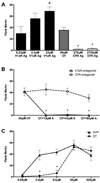Species, sex and individual differences in the vasotocin/vasopressin system: relationship to neurochemical signaling in the social behavior neural network
- PMID: 25102443
- PMCID: PMC4317378
- DOI: 10.1016/j.yfrne.2014.07.001
Species, sex and individual differences in the vasotocin/vasopressin system: relationship to neurochemical signaling in the social behavior neural network
Abstract
Arginine-vasotocin (AVT)/arginine vasopressin (AVP) are members of the AVP/oxytocin (OT) superfamily of peptides that are involved in the regulation of social behavior, social cognition and emotion. Comparative studies have revealed that AVT/AVP and their receptors are found throughout the "social behavior neural network (SBNN)" and display the properties expected from a signaling system that controls social behavior (i.e., species, sex and individual differences and modulation by gonadal hormones and social factors). Neurochemical signaling within the SBNN likely involves a complex combination of synaptic mechanisms that co-release multiple chemical signals (e.g., classical neurotransmitters and AVT/AVP as well as other peptides) and non-synaptic mechanisms (i.e., volume transmission). Crosstalk between AVP/OT peptides and receptors within the SBNN is likely. A better understanding of the functional properties of neurochemical signaling in the SBNN will allow for a more refined examination of the relationships between this peptide system and species, sex and individual differences in sociality.
Keywords: Affiliation; Aggression; Communication; Estradiol; Oxytocin; Pair bonding; Sociality; Testosterone; V1a; V1b.
Copyright © 2014 Elsevier Inc. All rights reserved.
Figures






References
-
- Absil P, Papello M, Viglietti-Panzica C, Balthazart J, Panzica G. The medial preoptic nucleus receives vasotocinergic inputs in male quail: a tract-tracing and immunocytochemical study. J Chem Neuroanat. 2002;24(1):27–39. - PubMed
-
- Acharjee S, Do-Rego JL, Oh DY, Moon JS, Ahn RS, Lee K, Bai DG, Vaudry H, Kwon HB, Seong JY. Molecular cloning, pharmacological characterization, and histochemical distribution of frog vasotocin and mesotocin receptors. J Mol Endocrinol. 2004;33(1):293–313. - PubMed
-
- Acher R, Chauvet J. The neurohypophyseal endocrine regulatory cascade: Precursors, mediators, receptors, and effectors. Front Neuroendocrinol. 1995;16:237–289. - PubMed
-
- Adkins-Regan E. Neuroendocrinology of social behavior. ILAR J. 2009;50(1):5–14. - PubMed
-
- Agnati LF, Fuxe K, Zoli M, Ozini I, Toffano G, Ferraguti F. A correlation analysis of the regional distribution of central enkephalin and beta-endorphin immunoreactive terminals and of opiate receptors in adult and old male rats. Evidence for the existence of two main types of communication in the central nervous system: the volume transmission and the wiring transmission. Acta Physiol Scand. 1986;128(2):201–207. - PubMed
Publication types
MeSH terms
Substances
Grants and funding
LinkOut - more resources
Full Text Sources
Other Literature Sources
Miscellaneous

